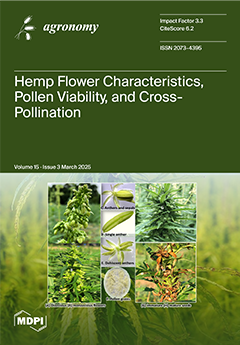Mercury (Hg) poses significant risks to human health, the environment, and plant physiology, with its effects influenced by chemical form, concentration, exposure route, and organism vulnerability. This study evaluates the physiological impacts of Hg on
Handroanthus impetiginosus (Ipê Roxo) seedlings through SPAD index
[...] Read more.
Mercury (Hg) poses significant risks to human health, the environment, and plant physiology, with its effects influenced by chemical form, concentration, exposure route, and organism vulnerability. This study evaluates the physiological impacts of Hg on
Handroanthus impetiginosus (Ipê Roxo) seedlings through SPAD index measurements, chlorophyll fluorescence analysis, and Hg quantification in plant tissues. Four-month-old seedlings were exposed for eight days to distilled water containing Hg at 0, 1, 3, 5, and 7 mg L
−1. The SPAD index decreased by 28.17% at 3, 5, and 7 mg L
−1, indicating reduced photosynthetic capacity.
Chlorophyll a fluorescence analysis revealed a 50.58% decline in maximum efficiency (Fv/Fm) and a 58.33% reduction in quantum yield (ΦPSII) at 7 mg L
−1, along with an 83.04% increase in non-photochemical quenching (qn), suggesting oxidative stress and PSII damage. Transpiration decreased by 26.7% at 1 mg L
−1 and by 55% at 3, 5, and 7 mg L
−1, correlating with Hg levels and leaf senescence. Absorption, translocation, bioconcentration, and bioaccumulation factors varied among treatments. Hg accumulated mainly in stems (40.23 μg g
−1), followed by roots (0.77 μg g
−1) and leaves (2.69 μg g
−1), with limited translocation to leaves. These findings highlight Hg’s harmful effects on
H. impetiginosus, an ecologically and commercially valuable species, addressing a gap in research on its Hg tolerance and phytoremediation potential.
Full article





